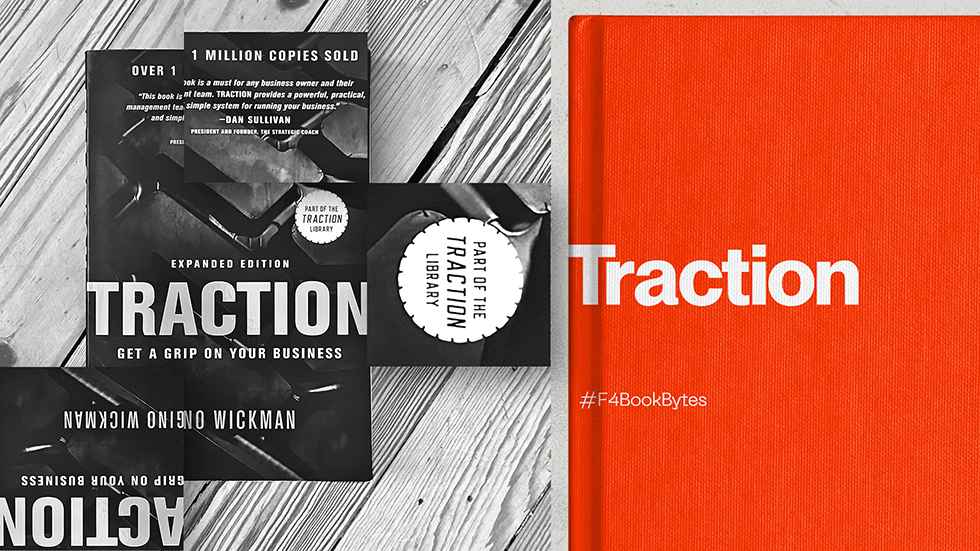#F4BookBytes
Our team compresses the wisdom and actionable inspiration gleaned from a variety of professional and creative books into bite-sized chunks as they pertain to the business, marketing, and communication challenges our colleagues and clients face.
At some point in their careers, most people in marketing and other fields will have to truly run something for the first time. It might be a small business, a department, a project, or a campaign. And that moment – the moment of transitioning from being a specialist to a leader – can be daunting. Some experience it in their early twenties, while others don’t step into leadership roles until their sixties. Regardless, when the time comes to take charge, creating a growth mindset is essential.
I first picked up Traction in 2020, a turning point for Fifteen4. We had just ended a significant client relationship when COVID hit the U.S., and business activity entered a six-month deep freeze. Our existing business model had exposed us to too much risk. To navigate the economic storm brought on by COVID mitigation policies and return to profitability, we had to rethink how we staffed projects, invested in talent, and leveraged a roster of freelancers and long-term contractors.
Employing Traction’s Entrepreneurial Operating System provided an invaluable framework for guiding the business through this transition. It helped us plan for both short-term and long-term challenges, conduct structured leadership conversations, and focus our efforts on reducing exposure to economic volatility. In simpler terms, it helped us stop panicking and start planning.
What It’s About
Traction starts with a simple yet profound idea: every organization, no matter how complex it seems, boils down to three key functions:
Sales + Marketing, Operations, and Finance + HR
At Fifteen4, this realization was vital in helping us approach company-wide change. Instead of drowning in endless to-do lists, we began categorizing our tasks into these three buckets. It streamlined our thinking and clarified our staffing needs. If you’re trying to lead all three functions by yourself, you’re in for a rough ride as your business grows. We learned this the hard way, and Traction helped us get back on track.
“You must get the right people
in the right seats.”
At the top of the company org chart are two types of leaders: the Visionary and the Integrator. We all know what the Visionary looks like – think Steve Jobs with his legendary product launches (“1,000 songs in your pocket!”). But not every company needs a Visionary once they’re up and running (though it certainly helps). What it does need is an Integrator, a role that gets less attention but is just as crucial. The Integrator, someone like Sheryl Sandberg, excels at understanding how a vision can be executed most effectively. For instance, Sandberg built the ad-buying platform that established Facebook’s dominance in social media advertising.
It sounds straightforward, but many Visionaries try to manage operations and fail, while many Integrators force themselves to generate bold new ideas that just don’t cut it. Knowing whether you’re a Visionary or an Integrator can save you from assuming a leadership role that doesn’t suit you.
Why It Matters to Marketers
Traction is a business book, not a marketing book, but it should be at the top of marketing leaders’ reading lists for three reasons:
1. You Manage a Team: Running a marketing team can sometimes feel like herding cats (maybe lions). But Traction is full of transformational guidelines that have reshaped how we operate at Fifteen4. From running effective meetings to identifying and managing top talent, establishing and tracking data on effectiveness, and creating optimal processes.
2. You Manage a Critical Business Function: Marketing isn’t just about creative campaigns and catchy slogans. Traction validated that we see marketing as a critical business function that interacts with every other department. It’s a mindset shift that we’ve embraced completely. Understanding how our marketing efforts align with the company’s overall business strategy has been crucial.
3. Your Ultimate Goal is Growth: At the end of the day, we’re all here to grow. For us, Traction has been a roadmap for promoting company-wide growth. It’s not just about increasing brand awareness or generating leads – it’s about driving sustainable, long-term success. We’ve seen firsthand how a robust business framework can fuel innovative growth strategies, and we’re excited to help our clients achieve the same.
“Without traction, a vision is a
pure hallucination.”
Four years after first reading Traction during the early days of the pandemic, our business is stable and profitable. The economy’s chugging along, our clients are happy, and we have new deals in the pipeline. We’ve built a lower-risk model that blends high-performing full-time staff with project-based freelancers. But we still use Traction’s Entrepreneurial Operating System to optimize our processes. No book has had a greater influence on how we approach running a business.
Traction: Get a Grip on Your Business
by Gino Wickman
Barnes & Noble | Amazon | Audible | Apple Books | Spotify | GoodReads

Meet blog author Will Smallman, Managing Partner
Read his bio here

